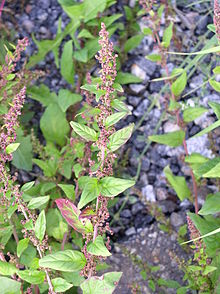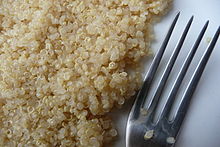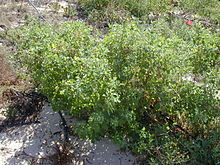- Chenopodium
-
- "Goosefoot" redirects here. The unrelated smearwort (Aristolochia rotunda) is sometimes called "Mercury goosefoot".
Goosefoots 
Many-seeded Goosefoot
(Chenopodium polyspermum)Scientific classification Kingdom: Plantae (unranked): Angiosperms (unranked): Eudicots (unranked): Core eudicots Order: Caryophyllales Family: Amaranthaceae Subfamily: Chenopodioideae Genus: Chenopodium Species Many, see text
Chenopodium is a genus of about 150[verification needed] species of perennial or annual herbaceous flowering plants known as the goosefoots, which occur almost anywhere in the world. It is placed in the family Amaranthaceae in the APG II system; older classifications separate it and its relatives as Chenopodiaceae, but this leaves the rest of the Amaranthaceae polyphyletic. However, among the Amaranthaceae, the genus Chenopodium is the namesake member of the subfamily Chenopodioideae. The genus Dysphania is closely related, and contains several species formerly placed in Chenopodium, such as epazote (D. ambrosioides).
In Australia, the larger Chenopodium species are among the plants called "bluebushes". Chualar in California is named after a Native American term for a goosefoot abundant in the region, probably the California goosefoot (C. californicum).
Uses and ecology
 Strawberry blite (C. capitatum) leaves are edible, as are the red inflorescences – though they look like fruit, they actually taste like spinach.
Strawberry blite (C. capitatum) leaves are edible, as are the red inflorescences – though they look like fruit, they actually taste like spinach.
The genus Chenopodium contains several plants of minor to moderate importance as food crops as leaf vegetables – used like the closely related spinach (Spinacia oleracea) and similar plants called quelite in Mexico – and pseudocereals. These include white goosefoot (C. album), Good King Henry (C. bonus-henricus), strawberry blite (C. capitatum), leafy goosefoot (C. foliosum), kañiwa (C. pallidicaule) and quinoa (C. quinoa). On the Greek island of Crete, tender shoots and leaves of a species called krouvida (κρουβίδα) or psarovlito (ψαρόβλητο) is eaten by the locals, boiled or steamed. As studied by Kristen Gremillion and others, goosefoots have a history of culinary use dating back to 4000 BC or earlier, when pitseed goosefoot (C. berlandieri) was a staple crop in the Native American eastern agricultural complex, and white goosefoot was apparently used by the Ertebølle culture of Europe.
There is increased interest in particular in goosefoot seeds today, which are suitable as part of a gluten-free diet. Quinoa oil, extracted from the seeds of C. quinoa, has similar properties, but is superior in quality, to corn oil. Oil of chenopodium is extracted from the seeds of epazote, which is not in this genus anymore. Shagreen leather was produced in the past using the small, hard goosefoot seeds. C. album was one of the main model organisms for the molecular biological study of chlorophyllase.
Goosefoot pollen, in particular of the widespread and usually abundant C. album, is an allergen to many people and a common cause of hay fever. The same species, as well as some others, have seeds which are able to persist for years in the soil seed bank. Many goosefoot species are thus significant weeds, and some have become invasive species.
Certain species grow in large thickets, providing cover for small animals. Goosefoot foliage is used as food by the caterpillars of certain [[Lepidoptera. The seeds are eaten by many birds, such as the yellowhammer (Emberiza citrinella) of Europe or the white-winged fairy-wren (Malurus leucopterus) of Australia. Goosefoot pathogens include the positive-sense ssRNA viruses - apple stem grooving virus, sowbane mosaic virus and tobacco necrosis virus.
Selected species
- Chenopodium acuminatum Willd.
- Chenopodium album – white goosefoot, nickel greens, dungweed, bathua, chandali, chandaliya, fat hen, lamb's quarters, pigweed
- Chenopodium album ssp. amaranticolor
- Chenopodium atrovirens – dark goosefoot, pinyon goosefoot
- Chenopodium auricomiforme
- Chenopodium auricomum – Queensland bluebush
- Chenopodium berlandieri – pitseed goosefoot, southern huauzontle, lambsquarters
- Chenopodium berlandieri ssp. nuttalliae (Saff.) H.D.Wilson & Heiser
- Chenopodium berlandieri var. bushianum
- Chenopodium berlandieri var. zschackii
- Chenopodium bonus-henricus – Good King Henry, perennial goosefoot, poor-man's asparagus, Lincolnshire spinach, markery
- Chenopodium botrys – Jerusalem oak goosefoot, Jerusalem oak, feathered geranium
- Chenopodium bushianum – village goosefoot
- Chenopodium californicum – California goosefoot, Indian lettuce
- Chenopodium capitatum – strawberry blite, blite goosefoot, strawberry goosefoot, strawberry spinach, Indian paint, Indian ink
- Chenopodium carinatum R.Br.
- Chenopodium chenopodioides – small red Goosefoot, saltmarsh goosefoot
- Chenopodium cristatum (F.Muell.) F.Muell.
- Chenopodium curvispicatum
- Chenopodium desertorum – desert goosefoot
- Chenopodium desertorum ssp. anidiophyllum
- Chenopodium desertorum ssp. desertorum
- Chenopodium desertorum ssp. microphyllum
- Chenopodium desertorum ssp. rectum
- Chenopodium desertorum ssp. virosum
- Chenopodium desiccatum – narrowleaf goosefoot
- Chenopodium erosum R.Br.
- Chenopodium ficifolium – fig-leaved goosefoot, small goosefoot
- Chenopodium foggii – Fogg's goosefoot
- Chenopodium foliosum – leafy goosefoot
- Chenopodium fremontii – Fremont's goosefoot
- Chenopodium giganteum D.Don – tree spinach
- Chenopodium glaucum – oak-leaved goosefoot, glaucous goosefoot
- Chenopodium helenense Aellen
- Chenopodium hians – Hians goosefoot
- Chenopodium hircinum Schrad.
- Chenopodium humile – marshland goosefoot
- Chenopodium hybridum – maple-leaved goosefoot, sowbane
- Chenopodium incanum – mealy goosefoot
- Chenopodium leptophyllum – narrowleaf goosefoot
- Chenopodium littoreum
- Chenopodium melanocarpum – black crumbweed
- Chenopodium missouriense – Missouri goosefoot (sometimes considered a variety of C. album)
- Chenopodium multifidum – cutleaf goosefoot
- Chenopodium murale – nettle-leaved goosefoot
- Chenopodium nitrariaceum (F.Muell.) F.Muell. ex Benth. – nitre goosefoot
- Chenopodium nuttalliae – huauzontle
- Chenopodium oahuense – ʻĀheahea (Hawaiʻi)
- Chenopodium opulifolium Schrad. ex W.D.J.Koch – grey goosefoot
- Chenopodium pallidicaule – kañiwa
- Chenopodium polyspermum – many-seeded goosefoot
- Chenopodium polyspermum var. acutifolium
- Chenopodium pratericola Rydb. – pale goosefoot, desert goosefoot, narrowleaf goosefoot
- Chenopodium probstii Aellen
- Chenopodium pumilio R.Br. – clammy goosefoot
- Chenopodium purpurascens – purple goosefoot
- Chenopodium quinoa – quinoa
- Chenopodium retusum
- Chenopodium rubrum – red goosefoot, coastblite goosefoot
- Chenopodium salinum – Rocky Mountain goosefoot
- Chenopodium simplex – giantseed goosefoot
- Chenopodium standleyanum – Standley's goosefoot
- Chenopodium strictum Roth
- Chenopodium subglabrum – smooth arid goosefoot, smooth goosefoot
- Chenopodium suecicum – green goosefoot
- Chenopodium truncatum
- Chenopodium urbicum – upright goosefoot
- Chenopodium × variabile (C. album × C. berlandieri)
- Chenopodium vulvaria – stinking goosefoot, notchweed
- Chenopodium watsonii – Watson's goosefoot
Formerly placed here:
- Dysphania
- Rhagodia baccata – berry saltbush (as C. baccatum)
- Suaeda australis – austral seablite (as C. australe, C. insulare)
Categories:
Wikimedia Foundation. 2010.





